Thomas Cole Biography
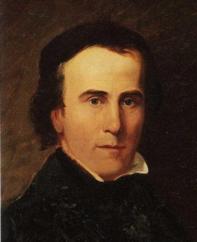
Thomas Cole was born on February 1, 1801, in the town of Bolton-le-Moor in Lancashire, England, into the family of James Cole, a woolen manufacturer, and his wife Mary.
According to some accounts, the first fourteen years of Thomas’ life were spent in great misery. In 1810, at the age of nine, Thomas was sent to school in the city of Chester, where he allegedly suffered from malnutrition, harsh discipline and sickness enough to scar him with memories of the experience for the rest of his life. Five years hence, in 1815, contrary to his father’s wishes, he was apprenticed to an engraver of designs working at a calico print factory, which did not offer a major improvement over his previous situation. It was only in 1817 that Cole managed to escape his wretched living conditions, after he found work as an engraver’s assistant in Liverpool.
By 1818, James Cole’s business had closed down and the family sailed to America, where they settled in Philadelphia on July 3 of the same year. Thomas quickly found a job, working as a textile print designer and wood engraver for various patrons. Among these commissions were a number of illustrations for John Bunyan’s book, Holy War. The rest of the Coles, meanwhile, unable to find any prospective work in the city, soon moved to the village of Steubenville, Ohio, leaving Thomas behind.
On January 4 of the following year, Cole sailed to the West Indies, arriving in St. Eustatius. However, due to lack of work he soon left, rejoining his family in Steubenville during the summer of the same year and began working with his father in a wallpaper-manufacturing business.
Cole’s artistic career only really began after 1820, when a traveling portraitist, Stein, happened to be passing through the village. At this time, Cole was advertising himself as an art teacher, which got Stein’s attention and consequently resulted in their acquaintance. It was from Stein that Cole learned the basics of painting.
Although, from the very beginning, he was more interested in landscape painting than anything else, the local economy was faring poorly, and few people were interested in art, especially landscape painting. As a result, Cole spent his first few years as a professional artist painting portraits.
By 1822, Cole had exhausted all available clients around the area, and so spent most of 1822 traveling around Ohio in search of commissions. In addition to portraits, he painted some religious works. Towards the end of the year, news from Steubenville of his family’s plans to move to Pittsburgh put an abrupt end to his travels and resulted in his swift return to the village. Upon arrival, however, he decided no to accompany his family on their new journey in favor of a chance to work for the Thespian Society, painting scenery, a job which lasted him through the winter of 1822 into the beginning of 1823.
This choice was apparently made only in part due to the young artist’s infatuation with and desire to draw landscapes, and stemmed also from the fact that he had acquired a debt over his travels which he wished to repay. Unfortunately, despite his employment by the Society, he was unable to make enough money to settle his affairs. He next attempted to pay off the remainder of the debt with several landscape paintings. However, neither the money nor the paintings were ever sent to those they were owed, and Cole abruptly left for Pittsburgh, leaving behind a letter to his creditors in which he claimed that he was completely bankrupt.
In the spring of 1823 he rejoined his family in the city and, not unlike before, was employed by his father in a new business. In the same year Cole had his first forays into painting out-of-doors, a practice which rekindled his desire to become a professional artist, and he once more began to make plans to depart in the hopes of finding work as a painter. He left for Philadelphia in November, much to the displeasure of his father, who saw few prospects in the idea of an artistic career. Cole started out on his latest journey completely penniless, but luckily found work at the Pennsylvania Academy of the Fine Arts, painting and making ornamental figures. He exhibited an unnamed landscape scene at the academy in 1824.
In 1825 he moved to New York City, after which he moved up the Hudson River and made some of his more notable paintings, among these Composition, Composition—A Storm, A Composition, A Tree and A Battlepiece, which were exhibited at the shop of a friend and attracted the attention of two important patrons, George W. Bruen and George Featherstonaugh. The sales finally garnered Cole enough esteem for Bruen to finance the artist’s trip to the Kaaterskill Falls and the ruins of Fort Putnam, over the course of which he painted several more landscapes, including A View of Fort Putnam, Lake with Dead Trees, The Falls of the Kaaterskill and View of Fort Ticonderoga from Gelyna. These new works found buyers almost immediately among fellow artists Colonel John Trumbull, William Dunlap and Asher B. Durand upon Cole’s return to the city. Through their acquaintance and ensuing friendship, he gained further renown, receiving many commissions from around the city and even other states.
Cole spent the winter of 1826 in the upper Hudson region, painting little, and then moved to the village of Catskill in the summer, to which he would return routinely for the next several years. The same year he began to exhibit his works at the National Academy of Design, of which he was a co-founder. His continued exhibition at this academy and also the American Academy of Fine Arts would gain him several more prominent patrons, such as Robert Gilmor, Jr. and Daniel Wadsworth.
The following several years saw Cole touring landmarks in the northeast of the country, including the White Mountains in New Hampshire in 1827 and the Niagara Falls in 1829. In this same period he exhibited the Expulsion from the Garden of Eden (1828) at the National Academy. The sale of these paintings to the aforementioned Robert Gilmor, who was persuaded to make the purchase after some close correspondence on the matter, earned Cole enough money to fund a voyage to England.
In the beginning of the summer of 1829 Cole embarked on his new journey, arriving in London several weeks later. Although his initial motivation for the trip was to get to see renowned English landmarks in person and learn from prominent English artists, he was, allegedly, dismayed by the rainy weather on the Isles and found that most of the local artists had little to offer in terms of new painting techniques, and tended to be rather unfriendly to boot. For the following two years, Cole exhibited his works at the British Institution and Royal Academy, but found that American landscapes were not particularly admired and even somewhat unwelcome contributions in the eyes of his English audience.
However, despite the general negativity encountered on the trip, Cole was able to make good friends with a handful of artists, among these Sir Thomas Laurence, who’d been made aware of Cole’s coming in a letter written to him by Robert Gilmor, as well as John Constable and John M. W. Turner.
In the beginning of 1831 he started a tour of the rest of Europe, beginning with Paris, France. Supposedly, his feelings about the trip were mixed, as he enjoyed the bright and sunny French weather over Britain’s wet climate, but found French contemporary art even more lacking than their English counterparts. During his stay he made several trips to various architectural monuments in the city, as well as the Louvre, but aside from the works of past artists found little that held his attention.
By June of the same year he arrived in Florence, where he finally found art which fit his rather selective interests, and was inspired to paint two paintings: an early precursor to his Sunset on the Arno (1837), and another landscape which would eventually become the basis for the first painting in his series, The Course of Empire. Cole remained in Florence for several months and, short of a small run-in with authorities which nearly cost him his stay in Tuscany, found the visit to be the most enjoyable thus far.
In the beginning of 1832 he visited Rome, but, unsurprisingly given his fascination with landscapes, didn’t find the city and its grandiose architecture as enthralling as the countryside. In early spring of the following year Cole traveled to Naples, where he tried to sketch out his first panorama of the Bay of Naples, but was prevented from completing the painting by the local authorities, who prohibited any drawings of the city from the vantage point of the castle overlooking it. He then returned to Florence following a short stay in Paestum, where he planned to stay for an indefinite amount of time, when he was suddenly called back to the United States. There had been an outbreak of cholera, and his parents had fallen ill. Cole departed for New York, arriving there towards the end of the year.
Shortly afterwards, Cole set up shop in the city, and in 1833 he met another prominent patron, Luman Reed, for whom Cole proposed to make perhaps his most famous series of paintings, The Course of Empire, the idea for which he had developed six years prior and had been wanting to execute ever since. The project would span five paintings, The Savage State (1833-1836), The Arcadian or Pastoral State (1833-1836), The Consummation of Empire (1833-1836), Destruction (1833-1836) and Desolation (1833-1836), and would take him three years to finish, which was unfortunately too long for Reed – who died before he saw the commission completed. However, despite the unfortunate turn of events, the unveiling of The Course of Empire to the public, and then his marriage to Maria Bartow in the following month, made 1836 a big year for Cole. The newlyweds settled in the village of Catskill, where Cole had made a habit of spending summers before his departure to Europe. In the same year, he finally settled the debt he had failed to repay almost ten years ago.
The next few years were busy for Cole as he worked hard to keep up with commissions. Among the more prominent paintings he made in this period were A View on the Catskill (1837)), Autumnal Scene (1837), View of Florence from San Maniato (1837), Dream of Arcadia (1838), Schroon Mountain (1838) and several two-picture series, such as Departure and Return (1837) and Past and Present (1838). In 1839 Cole was commissioned and began working on his second most renowned series, the Voyage of Life, which took him until the following year to complete and would include four paintings: Childhood (1839-1840), Youth (1840), Manhood (1840) and Old Age (1840). Ironically, given the theme of the series, the patron of this commission, too, did not live to see it finished. During this time, Cole also entered the architectural competition for Ohio State Capitol in 1838, placing third with his idea of a redesigned portico, styled to look like the Greek Parthenon.
In 1841 Cole once more traveled to England, where he stayed for a number of days in London before traveling to France, Switzerland and finally arriving in Rome in the winter. At the same time he began working on a second version of Voyage of Life, which he finished the following year. In the spring of 1842 Cole visited Sicily where he toured Mount Etna, and which he was inspired to capture in several pictures, including Mount Etna (1842) and later Mount Etna from Taormina (1843). He then returned to London in the summer and finally traveled back to the United States for the last time, but not without taking along several ideas for paintings inspired by the Italian landscape, which he would later execute in his The Temple of Segesta (1843) and Roman Compagna (1843).
Almost immediately after arriving, Cole joined the Episcopal Church, perhaps after being inspired by the devout faith he witnessed in Italy, and spent the next few years planning and painting pieces of a religious theme, including the two series Sowing and Reaping and Life, Death and Immortality, as well as L’Allegro (1843) and Il Penseroso (1843), although only the last two of these works were ever completed. At the same time, Cole took up lecturing fellow artists on the particulars of Sicilian scenery and in 1844 also took in a student, Frederick Church, with whom he went on several tours of the states, visiting Mount Desert, Maine in the summer of that year and the Niagara Falls in 1847. In 1845 he began working on what was perhaps the most famous of his later works, The Cross and the World, which regrettably was never finished before his death.
In 1848 Cole was struck by a debilitating disease which left him with a lung infection that soon proved to be fatal. After lingering for almost a week, Cole died on February 8, 1848.
Bibliography
Art of the United States of America. 1675-1975. by A. Chegodayev. Moscow. Iskusstvo. 1976. (in Russian)
The Life and Works of Thomas Cole by Louis Legrand Noble, Elliot S. Vesell (Editor). Black Dome Pr, 1997.
Thomas Cole (Famous Artists Series) by Matthew Baigell. Watson-Guptill Pubns, 1988.
Thomas Cole's Poetry: The Collected Poems of America's Foremost Painter of the Hudson River School by Thomas Cole, Marshall B. Tymn (Editor). George Shumway Pub, 1972.
Thomas Cole by Earl A Powell. Harry N. Abrams, Inc., Publishers, NY (1990).
from Broome County Public Library, Binghamton
All That is Glorious Around Us. Paintings from the Hudson River School by John Driscoll. Cornell University Press (1997)
Hudson River School Visions. The Landscapes of Sanford R.Gifford. by Kevin J. Avery, Eleanor Jones Harvey, Franklin Kelly and Heidi Applegate. The Metropolitan Museum of Art (2003).
American Paradise: The World of the Hudson River School by Kevin J. Avery. The Metropolitan Museum of Art (19873).
Hudson River And Its Painters by Hudson River And Its Painters by John K. Howat. Random House Value Publishing (1988)
- Landscape With Dead Tree.
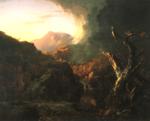
1828. Oil on canvas. 67.2 cm x 82.5 cm. Rhode Island School of Design, Museum of Art, Providence, Rhode Island, USA.
- Falls Of Kaaterskill.
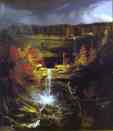
1826. Oil on canvas. The Warner Collection of Gulf Paper Corporation, Tuscaloosa, Alabama, USA.
- Gelyna (View Near Ticonderoga).
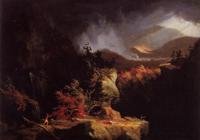
1826-1828. Oil on panel. Fort Ticonderoga Museum, Ticonderoga, NY, USA.
- Expulsion From The Garden Of Eden.
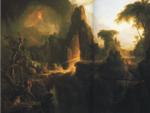
1827-28. Oil on canvas, 99 x 137 cm. The Museum of Fine Arts, Boston, MA, USA.
- The Course Of Empire: The Savage State.
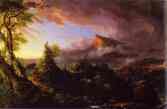
1836. Oil on canvas. The New York Historical Society, New York, NY, USA.
- The Course Of Empire: The Arcadian Or Pastoral State.

1836. Oil on canvas. 99.5 x 160.4 cm. New York Historical Society, New York, NY, USA.
- The Course Of Empire: The Consummation Of Empire.
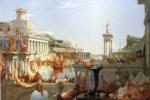
1836. Oil on canvas. 130 x 192.8 cm. New York Historical Society, New York, NY, USA.
- The Course Of Empire: Destruction.

1836. Oil on canvas. 99.5 x 161.2 cm. New York Historical Society, New York, NY, USA.
- The Course Of Empire: Desolation.
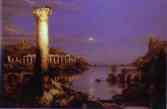
1836. Oil on canvas. 99.5 x 161.2 cm. The New York Historical Society, New York, NY, USA.
- View Of Florence From San Maniato.

1837. Oil on canvas. 39 x 63 1/8". The Cleveland Museum of Art, Cleveland, OH, USA.
- Dream Of Arcadia.

1838. Oil on canvas. 30 1/4 x 63 1/16". The Denver Art Museum, Denver, CO, USA.
- Schroon Mountain, Adirondacks.

1838. Oil on canvas. 99 x 160 cm. The Cleveland Museum of Art, Cleveland, OH, USA.
- The Departure.

1838. Oil on canvas. 39 1/2" x 63". The Corcoran Gallery of Art, Washington, DC, USA.
- The Return.

1838. Oil on canvas. 39 3/4" x 63". The Corcoran Gallery of Art, Washington, DC, USA.
- The Past.

1838. Oil on canvas. 40" x 61". Mead Art Museum, Amherst College, Amherst, MA, USA.